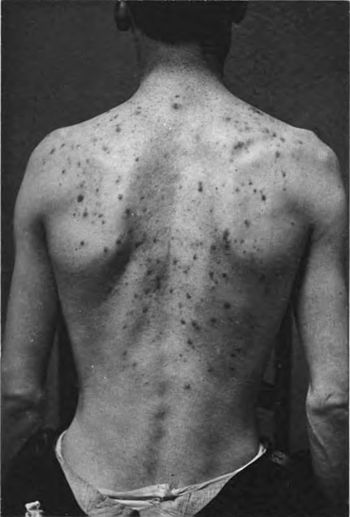Acne vulgaris (Photo credit: Wikipedia)
What Causes Adult Acne?
Regardless of age, acne is a condition of the sebaceous glands. These glands are attached to hair follicles and produce an oily substance called sebum. An acne lesion forms when a hair follicle becomes plugged with sebum and dead cells. The pathogenic (disease-causing) events in the sebaceous glands are believed to be due in large degree to changes in levels of androgenic (male) hormones in the body—a circumstance usually associated with the growth and development that occurs between the ages of 12 and 21. Therefore, it is important to look for an underlying cause of acne that occurs for the first time in adulthood.
Acne that appears after 25 to 30 years of age occurs for one of these reasons:
1. Recurrence of acne that cleared up after adolescence
2. Flare-up of acne after a period of relative quiet—for example, during pregnancy
3. Occurs for the first time in a person who had never previously had acne.
Acne that appears for the first time in adulthood should be examined by a dermatologist who can investigate the underlying cause. Some causes of adult acne are:
* Medication. Some medications that can induce acne include anabolic steroids (sometimes used illegally by athletes to “bulk up”), some anti-epileptic medications, the anti-tuberculosis drugs isoniazid and rifampin, lithium and iodine-containing medications.
* Chronic physical pressure on the skin. Chafing from the straps of a backpack or tucking a violin between the jaw and chin can cause chronic physical pressure on the skin and may induce a condition known as acne mechanica.
* Chlorinated industrial chemicals. These may induce the occupational skin disorder known as chloracne.
* Metabolic conditions. Changes in the hormonal balance, such as those brought about by pregnancy, menstruation or hormonal abnormalities can induce acne.
It is also important to know that some lesions which appear to be acne are not acne at all. One skin condition that resembles acne is folliculitis, which occurs when the hair follicles become infected and inflamed. Folliculitis requires different treatment than acne.
Acne that occurs in adulthood may be difficult to treat if there are multiple recurrences. Some patients with severe recurrent acne have undergone repeated courses of treatment with the potent systemic drug isotretinoin.
Since adult acne may be difficult to treat, acne that appears for the first time in adulthood should be examined and treated by a dermatologist.
What is acne?
According to certain studies, acne varies from quite mild to tremendously severe. It typically forms when the lining of the skin duct as well as the sebaceous glands start to work overtime. With the onset of acne, the lining of the duct actually shed cells which
are then transported away to the shell of the skin by the sebum. Once the duct is blocked, it is when the sebum and cells start to amass, forming a plug known as comedo.
Once the plug stays below the plane of the skin, whiteheads or “closed comedo” occurs. If the plug boosts and pops out of the skin duct, it is called “open comedo” or blackhead since the top is dark. As you may know, this is not absolutely dirt, thus it will not wash away.
There are a lot of factors that contribute to the formation of acne, but in terms of its real cause, no one is actually certain as to what exactly causes acne to develop or why it starts in adolescence. However, factor like hereditary top the list. It has long been deemed as the most important factor that plays a large role in the acne’s development. As what most people believe, if a member of your family had acne, there is a great possibility that you will have acne too.


No comments:
Post a Comment